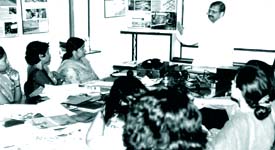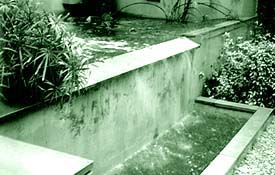People of Alwar revived river Arvari and formed an Arvari Sansad or Parliament to decide how best to protect and utilise the river water. People from 70 villages located in the catchment area of the river took the decision not to let anyone exploit the river’s water at the first session of the Arvari Sansad on January 26-27, 1999, at village Hamirpur. By the time the Arvari Sansad met for a second time, on June 5-6 in Samra village, it was clear that the villagers were determined to carry out all their plans of self river management. Barley is the predominant crop in this area. But it is also an essential raw material for breweries. A consequence of increased freshwater availability was that a known corporation wanted to set up a brewery in the region. "But the villagers got together to ensure that no industrial concern exploited the river’s resources,"says Rajendra Singh, secretary, Tarun Bharat Sangh (TBS), the Alwar based voluntary organisation that mobilised people to revive the practice of building johads (earthen dams) to harvest rainwater. Callous industrialists out to make a quick buck are not the only threat to
the river. Overextraction of water by the farmers of the area is also harmful. To
safeguard against this, the Parliament adopted an elaborate set of rules and regulations
that are practical and can be implemented through existing village level institutions. In
addition, Girdhari Meena of Hamirpur put forward the proposal that people with farms along
the river would not lift water through tubewells. This was accepted unanimously by the Arvari
Sansad after noting that the flow of the river was less compared to the previous year,
due to cultivation of water intensive crops like chili, vegetables, sugarcane and wheat
along its banks. The Arvari Sansad hasbrought back the bondedness that had been lost among the people. Another important decision was to ban the selling of riverwater extracted through tubewells. However the Arvari Sansad made a special concession for farmers who had lost their lands to the rising level of the river. It was decided that such farmers could use tubewells to lift the river water but only till the festival of Holi. This would ensure that the river had enough water in summer. It was also decided that farmers could dig shallow wells at a little distance from the river to obtain groundwater. But this will be restricted after Holi. It was agreed at the Arvari Sansad that village assemblies would not allow farmers who failed to follow regulations from irrigating their lands. In turn, if village assemblies failed to enforce regulations, then the Arvari Sansad would take them to task. The Sansad also made a study to see how many of the norms adopted at the first session had been implemented. It was found out that 70 per cent were being followed.
Rangan Dutta,Director General of the Council for Advancement of Peopleís Action and Rural Development (CAPART), New Delhi, was present at the second session as an observer. "I found it fascinating. All the issues of development economics were being tested on the ground level. People in these villages take lot of pride in what they have achieved. In sharp contrast, government-sponsored watershed management programmes are not showing any visible signs of success. People’s participation makes all the difference,"he says. Dutta believes that the Arvari Sansad will have to widen its scope, as there will be more issues to deal with once water becomes surplus. But he is confident about the capability of the villagers. "Democracy is the only solution," he states. The Arvari Sansad has provided a common platform and brought back the bondedness that had been lost among the people. "There is a new bond among the people — they are joined not just by the river but by the bond of sweat," says Anupam Mishra, head of the environment cell of Gandhi Peace Foundation, New Delhi, and chairperson of Tarun Bharat Sangh.
The CSE’s Environment Education and Natural Resource Management teams have received enthusiastic response from schools who are keen to capture rain water and install water harvesting structures. A presentation was made before school teachers attending a training workshop organised by the Environment Education team in July. The need, advantages and options available for water harvesting were clearly spelt out. The teachers were taken on a tour of traditional water harvesting structures around Delhi and also shown efforts to harvest rainwater at CSE. This generated tremendous response. Schools are now getting immersed in water issues: some want to install water harvesting structures, others are doing a water audit and still others are trying to gather information on aquifers in their area. Interest has been kindled off and will hopefully lead to the just valuation of water and its conservation.
Assessing desertification and water harvesting in the Middle East and North Africa: In July 1999, the Centre for Development Rrsearch, ZEF Bonn, an interdisclipinary research institute at the University of Bonn published a study ‘Assessing desertification and water harvesting in the Middle East and North Africa: policy implications’. The objective of this study was to monitor the effect of desertification, its effect on productivity, and the current status of water harvesting techniques and their potential in combatting desertification. New deserts are forming in many areas of the world, and in regions where
food security and poverty alleviation are priorities, such as in the Middle East and North
Africa (MENA region), land availability, degradation and efficient use of land and water
management are of vital importance. The MENA region extends over 17 countries,
representing a total land mass of 9.5 million square kilometres, representing 7 % of the
total world land area. Population growth rate is the highest- 3.4 % in 1995. The Edom mountains in southern Jordan house relics of water harvesting systgems that are 9000 years old The region has poor land and water availability. The water situation on the MENA region is precarious, both in terms of quality and quantity. Demands far exceed supply- four of the MENA countries consume more than 100 % of their renewable water resources. Some countries share groundwater basins while others share rivers. Land degradation is a serious problem. Land degradation has many reasons, ranging from overgrazing, shrubs clearing and soil erosion in range lands to salinisation and alkalinisation in irrigated lands. This paper looks at policy actions and implications against a background of what is being done in the MENA region to address desertification problems, and government and non government efforts at water harvesting. The first water harvesting system in history was built in the MENA region- signs of early water harvesting systems that date back 9000 years have been found in the Edom mountains in southern Jordan. In Egypt, some of the water harvesting structures built in the Roman era have been cleaned and put to use. The paper describes the various types of water harvesting that are being practised in the region and cites the Egypt experience of water harvesting as an example. The case study describes the identification of the catchement area, water storage techniques, socio-economic indicators of succesful water harvesting in Egypt, land tenure systems, and the impact of water harvesting. Policy implications include the need for database improvement and research on alternatives and options. Source: Mamdouh Nasr, 1999, assessing desertification and water harvesting in the Middle East and North Africa, policy implications, number 10, ZEF- discussion papers on development policy, Bonn, July 1999. |
||||||



 CSE
is also practesing what it preaches water harvesting structure are in place new vew
to harvest the rainwater that falls (See Picture) at the CSE office in New Delhi
CSE
is also practesing what it preaches water harvesting structure are in place new vew
to harvest the rainwater that falls (See Picture) at the CSE office in New Delhi